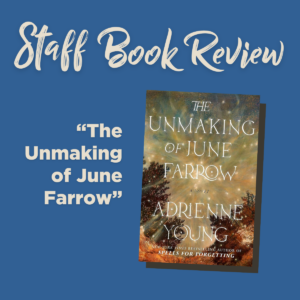Thanks to Zachary Harris, your Library’s Local History and Genealogy Specialist, for sharing the history of the modern day Tweetsie Trail in Johnson City and Elizabethton. In our “History Under the Blue Ridge” series, Zachary highlights intriguing stories he finds during his work in the Tennessee Room and with the online Johnson City Press archive.
The Tweetsie Trail, a gravel trail that stretches about 10 miles between Elizabethton and Johnson City, is a favorite spot for local hikers and bikers. Established in 2014, the trail is known as a “rails-to-trails” project because it follows the old path of the historic East Tennessee & Western North Carolina Railroad.

Through my research in the Library’s Tennessee Room and the online Johnson City Press Archive, I learned about the Tweetsie’s long history.
The Tweetsie railroad, named for the iconic high-pitched whistle of its engines, ran from its heyday in the mid 1800s until its decline in the 1950s. At the height of the rail’s popularity, the engines hauled material from the Cranberry, North Carolina mines and iron furnace. Shipping material from massive iron veins in North Carolina to and through Johnson City helped the city and the rail become integral in connecting Appalachia to a national rail system.
The Tweetsie’s rails were about two feet narrower than the average national standard. I don’t have to tell you that the East Tennessee Highlands and the Blue Ridge Mountains are windy and difficult terrain. Bringing the ET&WNC railroad through it with the standard tracks proved problematic. Instead, to get the tracks to fit in the narrow valleys and twists of the mountain ranges, the Tweetsie’s tracks were only three feet across.
In its prime, this little engine was very popular with locals. Affectionate names for the rail included the “Railway with a Heart,” or (a personal favorite of mine) the “Eat Taters and Wear No Clothes” railway. A large part of this local affection came from the popularity of its longtime conductor, Cy Crumley. Operating through the Great Depression, Crumley supposedly let folks ride for free and delivered their groceries.

Excursion trips between Boone and Johnson City on the Tweetsie during the Great Depression resulted in many of the popular remembrances and myths about the train. Crumley, with his heart-shaped ticket punch, garnered such a reputation that he and the train were featured in the “Tennessee Tweetsie” film. This 1938 film helped generate many dramatizations of the rail and its passengers. Scenes in the short film showed rail workers removing cattle from the tracks and passengers dressed in stereotypical “Old Southern” attire.
The train had a reputation for stopping anywhere along the track to pick up passengers and deliver goods like stoves or even coffins. In fact, during the Great Depression moonshine in Appalachia reportedly made its way along the Tweetsie as well. According to the book “Tweetsie Country,” Crumley said that one of his regulars “made good corn liquor…a little better than Jim Bean.”

The beloved Tweetsie would continue to run until 1950, following decades of decline along sections of the ET&WNC rail. On September 24, 1950, company officials took a farewell journey, and a month later the Tweetsie took its last freight trip. Crumley, the brakemen, and regular railroaders pulled the Tweetsie into Elizabethton that October day, the final official destination of the narrow gauge.
Today, you can still travel the distance between Johnson City and Elizabethton on the Tweetsie Trail. Next time you’re biking or walking the trail, take a minute to reflect on how things have changed; gone are the days of passenger rails and daylong excursions. Where there was once the quiet of hollers and mountain switchbacks occasionally pierced by the shrill whistle of a passing train, there’s only the quiet of the trail now. Take a moment to imagine what it was like to hear that train whistle coming and to catch a ride on the Tweetsie through the quiet countryside.
Much of this history was found in the Library’s new digital Johnson City Press archive, which dates back to 1934. This archive can only be accessed through the Library’s WiFi on our public computers or your personal device. It is available courtesy of Ancestry and Newspapers.com.
More News





